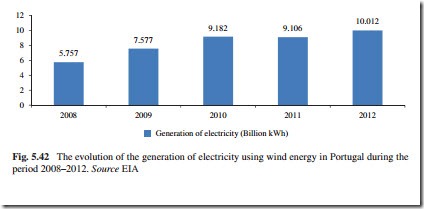Portugal
According to Zervos and Kjaer (2008), the measures adopted so far in Portugal in relation to the use of renewable energy sources for the generation of electricity constitute a comprehensive policy mix, complete with monitoring system.
In Portugal, the following measures have been taken to stimulate the uptake of the use of renewable energy sources for the generation of electricity:
• FiTs per kWh exist for solar PV, wave energy, small hydro, wind power, forest biomass, urban waste, and biogas;
• Tendering procedures were used in 2005 and 2006 in connection with wind and
biomass installations;
• Investment subsidies up to 40 % can be obtained;
• Tax reductions are available.
The use of renewable energy sources for the generation of electricity target to be achieved by Portugal in 2010 is 39 % of gross electricity consumption. Portugal, which nearly met its renewable energy target for 2010 in 1997, has now moved further away from this target. Portugal’s binding 2020 renewable target is 31 % up from 20.5 % in 2005, although the NREAP has reduced the 2005 starting point to 19.8 %. The overall target has been split into 55.3 % electricity from renewable, 30.6 % heating and cooling from renewable, and 10 % renewable in transport.
According to the approved plan, with an annual production of 14.6 TWh, wind power should be the country’s leading renewable technology covering almost 23 % of electricity consumption with a cumulative installed capacity of 6,800 MW onshore and 75 MW offshore by 2020 (total 6,875 MW; see Table 5.27). These
targets are below EWEA’s scenario, whereas the wind’s share of the power mix is similar in the two forecasts, although the NREAP indicates a 17 % increase in electricity consumption between 2010 and 2020. The forecast build-out rates in 2011 and 2012 are similar to recent developments in the Portuguese market (around 670 MW net annual increases). Subsequently, there is a two-year lull in new wind build-out, with a further 500 MW net capacity coming online in 2015, 2016, and 2017 are also forecast by the plan to be quieter years. Offshore build- out is seen as starting in 2015, with the first 25 MW installed and the remaining 50 MW all installed in 2020. The total wind power-installed capacity in 2011 reached 4,379 MW. In 2013, this capacity increased up to 4,724 MW; this represents an increase of 4.4 % with respect to 2012 and 7.9 % with respect to 2011. In that year, 191 MW new wind power capacity was added. The major increase in wind power capacity installed in one year was reached in 2005 (95.8 %).
Generation of Electricity Using Wind Energy
The evolution of the generation of electricity using wind energy in Portugal during the period 2008–2012 is shown in Fig. 5.42.
According to Fig. 5.42, the generation of electricity in Portugal using wind power during the period 2008–2012 increased 73.7 %. In 2013, the total electricity generated in the country using wind farms reached 24.6 %, the second in the EU after Denmark (33.8 %). It is expected that the generation of electricity in the country using this type of energy source will continue increasing during the coming years. The total wind farms operating in the country reached 246 in 2013.
Finally, it is important to highlight the following: Wind energy is very intermittent. Currently, since the wind has dispatched priority in Portugal, the intermittency of wind is compensated by natural gas power plants, which have fast online/off-line times. In the future, the intermittency of wind may also be compensated by better electricity storage techniques (for example, batteries in electric vehicles), by a supergrid able to integrate many countries, or by other renewable
technologies. In particular, solar energy is probably a good match to wind: Solar will be stronger exact during the periods where the wind is weaker (the middle of the day and the summer months).

